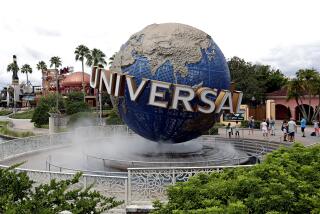ITT Expansion to See Face-Lift of Caesars, New Casino-Resorts
- Share via
In one of the largest corporate investments in gaming, ITT Corp. on Thursday announced a $2.5-billion expansion of its casino operations that includes a dramatic make-over of the famed Caesars Palace in Las Vegas and the development of a new chain of Planet Hollywood-themed casino-resorts.
The ambitious plans of New York-based ITT--which paid $1.7 billion less than two years ago to buy Caesars World, owner of Caesar’s Palace and other casinos-hotels--will help keep the company competitive with other rapidly growing industry giants, such as Hilton Hotels Corp. and Mirage Resorts Inc. Las Vegas already has seen two giant gambling complexes open this year and expects a third to open by December, swelling the city’s inventory of guest rooms by more than 6,500. “We will ensure that our competitiveness in gaming is retained and enhanced,” said Rand V. Araskog, chairman and chief executive of ITT, in a statement. “The development plans we announced today will significantly strengthen Caesars in its key destinations.”
ITT Corp., which has expanded into the glamorous gambling and entertainment business while spinning off its financial subsidiaries, will partner with Planet Hollywood International to build and operate a chain of casino-resorts bearing the name of the restaurant chain backed by such stars as Sylvester Stallone and Arnold Schwarzenegger. Planet Hollywood will receive 20% of resort revenues whereas ITT will get securities equal to a 5% stake in Planet Hollywood as well as the remainder of the revenue.
Designed to appeal to a broader market than the high rollers attracted to Caesars Palace, the first two Planet Hollywood casinos will rise in Las Vegas and Atlantic City, N.J., in 1998. In Las Vegas, ITT will spend $830 million to build a 3,400-room Planet Hollywood casino on the 34-acre site of the former Desert Inn. Its sister casino in New Jersey will cost an estimated $490 million and feature 1,000 guest rooms and a 100,000-square-foot casino.
The company also has begun construction on a $280-million project to add 620 guest rooms and 40,000 square feet of casino space to its Caesars Atlantic City.
ITT will spend an estimated $900 million to expand and polish the luster of one of the nation’s most well-known casinos: Caesars Palace in Las Vegas. The now-30-year-old hotel-casino, one of the first lavish gambling resorts to open on the Las Vegas Strip, has long appealed to high rollers and a glamorous clientele drawn to high-stakes games and highly publicized boxing matches.
Despite the addition of a popular shopping mall to the casino’s fountains and life-size models of Roman centurions, Caesars Palace has been hurt by the huge new neighboring resorts that cater to families and slot-machine players. The casino also has been limited by the relatively paltry number of its hotel rooms--1,500, compared with as many as 5,000 rooms at the nearby MGM Grand.
Under the expansion program, the number of Caesars Palace hotel rooms will more than double to about 3,500. In addition, its 120,000-square-foot casino will grow by almost 50%, and new entrances, outdoor arenas and shopping areas and a fitness center will be built.
“It’s been too small,” said Neil Barsky, a gaming industry analyst at Morgan Stanley & Co. “Had they been bigger, they could fill another 2,000 rooms a night.”
The expansion of Caesars Palace and the addition of the Planet Hollywood resort will only intensify competition as a wave of casino construction sweeps Las Vegas. In addition to the three new casinos opening this year, the MGM Grand has begun a $250-million expansion while Mirage Resorts is building the world’s most expensive hotel-casino, the $1.25-billion Bellagio.
“The city is going to evolve into a completely different place,” said industry analyst Joseph V. Coccimiglio at Dean Witter Reynolds. “I think it will make the town that much more interesting.”
More to Read
Inside the business of entertainment
The Wide Shot brings you news, analysis and insights on everything from streaming wars to production — and what it all means for the future.
You may occasionally receive promotional content from the Los Angeles Times.










